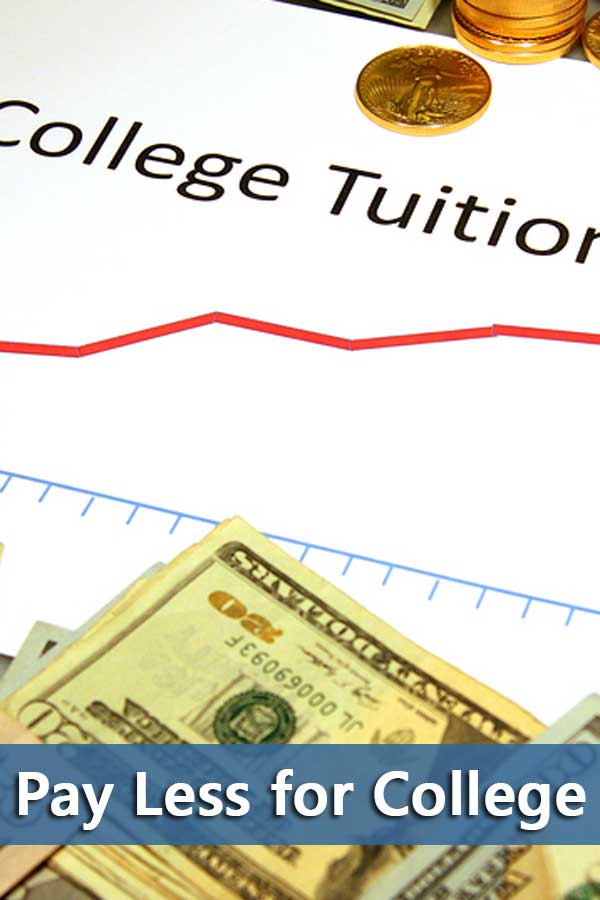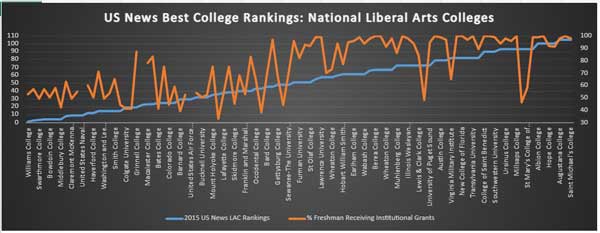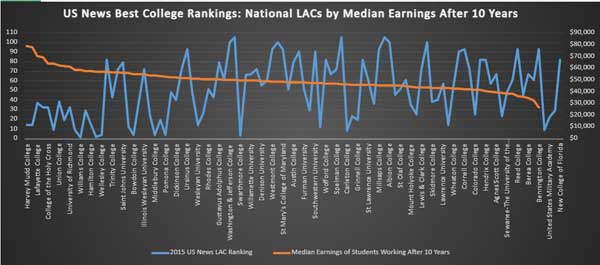 In my last post, I talked about how even colleges are subjected to the laws of supply and demand. The more students want to attend a college, the more the college can charge. If you want to pay less for college, you need to consider colleges with higher acceptance rates. Now I want to look at why so many students are interested in the same college. What makes 50 or fewer colleges so much more attractive than the remaining 1,500? Can you say “college rankings?”
In my last post, I talked about how even colleges are subjected to the laws of supply and demand. The more students want to attend a college, the more the college can charge. If you want to pay less for college, you need to consider colleges with higher acceptance rates. Now I want to look at why so many students are interested in the same college. What makes 50 or fewer colleges so much more attractive than the remaining 1,500? Can you say “college rankings?”
Actually, I need to be more specific, I’m talking about US News Best College Rankings. These rankings have been around the longest and for better or worse, are the most influential. Now I’ve talked about rankings before here, here, here, here, here, here, here, here, … well you get the point.
For those who want the short version, the problem with rankings is deciding what to rank. Consider cars, do rank them by the fastest, the cheapest, or the most popular? Usually rankings make up some combination of factors, with some given more importance than others.
In the case of US News Best College Rankings, popularity is a major factor in the rankings. No, it’s not called “popularity” but rather academic reputation and it accounts for over 20% of the rankings. Reputation is determined by a survey of college officials who for some reason US News believes would be completely objective about the process.
The fact is that US News isn’t really interested in an objective definition of reputation since it explicitly states that reputation shouldn’t be based on measurable criteria. How else can they expect the same schools to appear in the top ten year after year?
So what does this mean for families who want to pay less for college? If you believe that the rankings are an indicator of popularity, then more students with better qualifications will be applying to these schools. And as I showed before, as more students apply, the acceptance rates decline, and the cost of college increases.
This means that higher ranked colleges are generally going to cost more than lower ranked institutions.
The question is do these higher ranked institutions deliver a more valuable education that justifies the higher prices? Do they produce better results than lower ranked colleges? The fact is that is hard to tell since they accept “better” students and you would expect better results.
In a way, the answer to the question is irrelevant as far as paying for colleges goes. The fact is that the rankings exist and if you want to attend a higher ranked school, you can expect to pay more.
The chart below shows the top 105 National Liberal Arts Colleges according to US News Best College Rankings. The blue line is the rankings. The orange line shows the percentage of freshman receiving institutional aid. The missing points are US Military Academies.
Among the schools ranked in the top 30, 21 gave 60% or less of freshman institutional grants, 12 one provided 50% or less. There were only 2 schools were 80% or more of freshman received institutional grants. Of the 18 schools ranked between 30 and 50, half awarded less than 60% of freshman institutional aid. Two, colleges ranked 40 and 45, provide more than 80% of freshman with institutional aid.
Of the next 50 schools (52 because of ties), 90% or more of freshman at 40 of the colleges, received institutional aid. Only three, one of them a public college, had less than 60% of freshman with institutional aid.
Now some would argue that the higher cost colleges deliver more value, a better return on your investment. That’s hard to say and not only because you need to account for the different qualifications of the students. The fact is that colleges haven’t been exactly forthcoming in supplying information on salaries and acceptance rates into graduate school.
The recently release College Scorecard data includes median earning after 10 years information. This data has all kinds of limitations including not being adjusted for majors. However, until colleges decide to providing more useful information, this is what we have available.
In the graph below, the orange line is the median earnings after 10 years. The blue line is the schools position in US News Best College Rankings for National Liberal Arts Colleges.
Even though these are all Liberal Arts Colleges, three of the top four schools by earnings have a substantial percentage of graduates with engineering majors. The top 50 colleges ranked by median earnings includes 20 ranked in the bottom half of US News Best College top 100 National Liberal Arts Colleges. That includes six ranked below 90.
Of course, none of these numbers really prove anything statistically. But that’s actually the point. If you can’t prove that a higher ranked college is worth the cost, why not consider a lower ranked one that gives you a better deal?
You can use either the Comprehensive or Essential DIY College Search Spreadsheet to search for colleges by percentage of freshman receiving institutional grants and the average award.




2 thoughts on “How to Pay Less for College: The Value of Rankings”